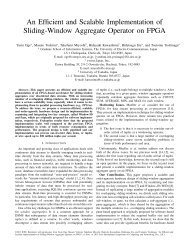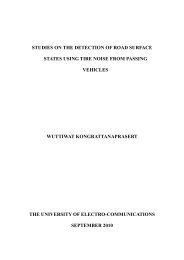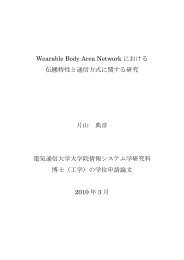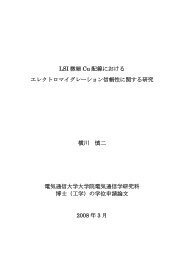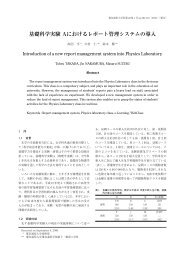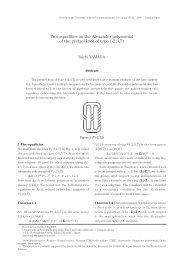Approximation of Hessian Matrix for Second-order SPSA Algorithm ...
Approximation of Hessian Matrix for Second-order SPSA Algorithm ...
Approximation of Hessian Matrix for Second-order SPSA Algorithm ...
Create successful ePaper yourself
Turn your PDF publications into a flip-book with our unique Google optimized e-Paper software.
1.1 MOTIVATION AND BACKGROUND<br />
Fig. 1.1. Example <strong>of</strong> stochastic optimization algorithm minimizing loss function L θ 1<br />
, θ ).<br />
(<br />
2<br />
This dissertation focuses on the case where such an approximation is going to be used as a result<br />
<strong>of</strong> direct gradient in<strong>for</strong>mation not being readily available. Overall, gradient-free stochastic<br />
algorithms exhibit convergence properties similar to the gradient-based stochastic algorithms<br />
[e.g., Robbins-Monroe stochastic approximation (R-M SA)] while requiring only loss function<br />
measurements [5][6]. A main advantage <strong>of</strong> such algorithms is that they do not require the<br />
detailed knowledge <strong>of</strong> the functional relationship between the parameters being adjusted<br />
(optimized) and the loss function being minimized that is required in gradient-based algorithms.<br />
Such a relationship can be notoriously difficult to develop in some areas (e.g., non-linear<br />
feedback controller design), whereas in other areas (such as Monte Carlo optimization or<br />
recursive statistical parameter estimation), there may be large computational savings in<br />
calculating a loss function relative to that required in calculating a gradient. To elaborate on the<br />
distinction between algorithms based on direct gradient measurements and those based on<br />
gradient approximations from measurements <strong>of</strong> the loss function, the prototype gradient-based<br />
algorithm is R-M SA, which may be considered a generalization <strong>of</strong> such techniques as<br />
deterministic steepest descent and Newton–Raphson, neural network back-propagation (BP),<br />
and infinitesimal perturbation analysis–based optimization <strong>for</strong> discrete-event systems [9]. The<br />
gradient-based algorithms rely on direct measurements <strong>of</strong> the gradient <strong>of</strong> the loss function with<br />
respect to the parameters being optimized. These measurements typically yield an estimate <strong>of</strong><br />
the gradient because the underlying data generally include added noise. Because it is not usually<br />
the case that one would obtain direct measurements <strong>of</strong> the gradient (with or without added<br />
noise) naturally in the course <strong>of</strong> operating or simulating a system, one must have detailed<br />
knowledge <strong>of</strong> the underlying system input–output relationships to calculate the R-M gradient<br />
estimate from basic system output measurements. In contrast, the approaches based on gradient-<br />
3



